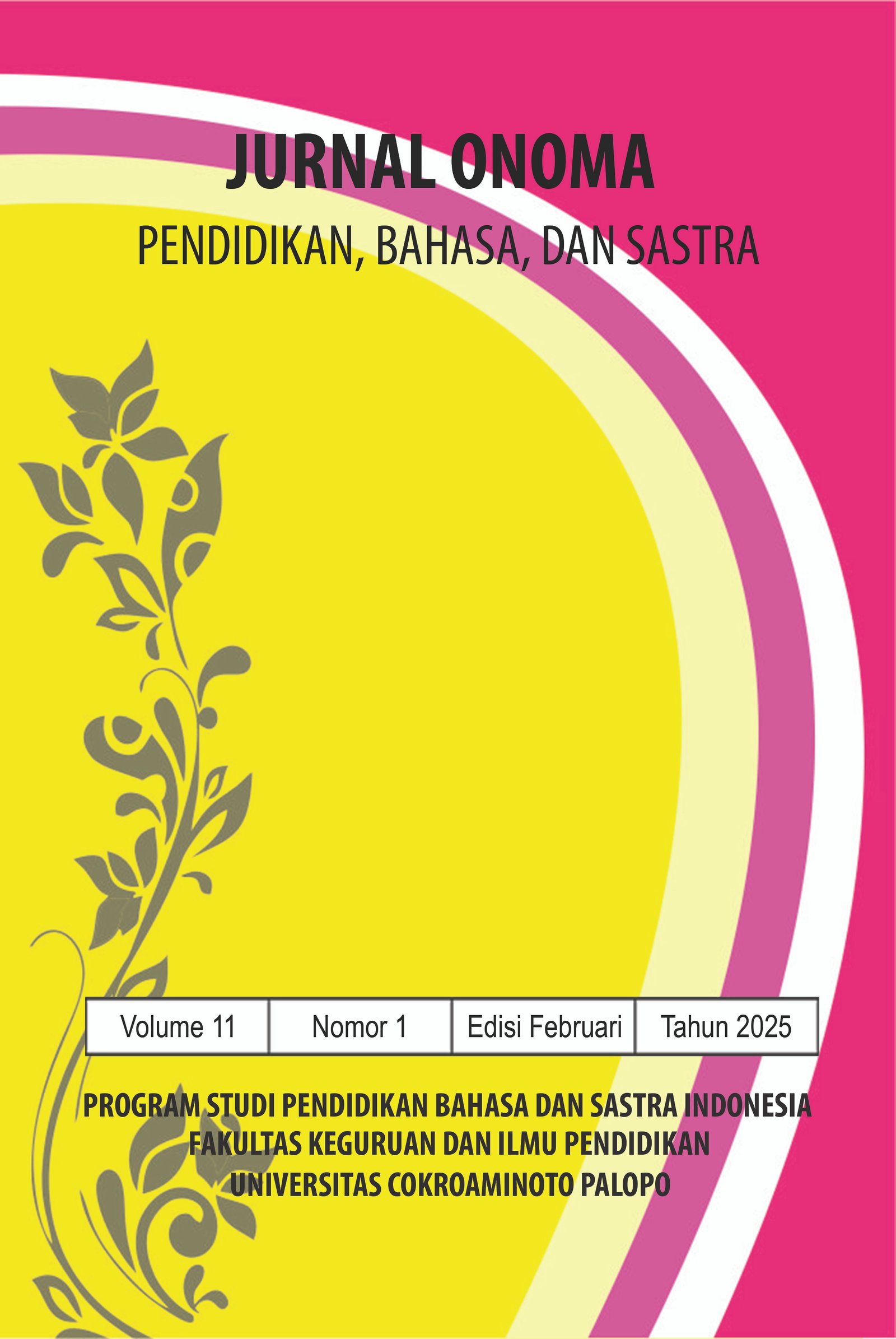Pengembangan Model Pembelajaran Menulis Teks Iklan Berbantuan Sumber Belajar Multimodal
https://doi.org/10.30605/onoma.v11i1.5170
Keywords:
model pembelajaran, menulis, teks iklan, sumber belajar multimodalAbstract
Penelitian ini bertujuan untuk menghasilkan model pembelajaran menulis teks iklan berbantuan sumber belajar multimodal. Penelitian ini menggunakan metode R&D (Research and Development) dengan model yang dikembangkan oleh Borg and Gall (1985), Research and Development yang terdiri dari tujuh tahapan, (1) tahap studi pendahuluan, (2) tahap perencanaan, (3) tahap pengembangan desain, (4) tahap uji ahli, (5) tahap revisi, (6) tahap uji coba lapangan terbatas, dan (7) revisi produk akhir. Hasil akhir produk ini berupa model pembelajaran yang terdiri dari sintaks, sistem sosial, prinsip reaksi, dan sistem pendukung. Sintaks pembelajaran terdiri dari tahap memotivasi siswa, menyajikan infromasi, mengorganisir siswa, memberikan stimulus, memberikan pelatihan, dan mempresentasikan hasil kegiatan dan evaluasi. Berdasarkan hasil uji ahli dan praktisi, diketahui bahwa produk melampaui 80% kriteria layak. Dengan demikian, model pembelajaran ini layak dan dapat diimplementasikan dalam pembelajaran menulis teks iklan.
Downloads
References
Abidin, Y. (2014). Desain Sistem Pembelajaran Dalam Konteks Kurikulum. Refika Aditama.
Agustrijanto. (2006). Copywriting: Seni Mengasah Kreativitas dan Memahami Bahasa Iklan. Bandung: PT. Remaja Rosda Karya.
Boogs, G. L. (2016). Teachers’ Perceptions about Teaching Multimodal Composition: The Case Study of Korean English Teachers at Secondary Schools. English Language Teaching, 9(6). DOI: https://doi.org/10.5539/elt.v9n6p52
Firmansyah, M. (2019). Literasi Multimodal Bermuatan Kearifan Lokal serta Implementasinya dalam Pembelajaran. Jurnal Ilmiah Edukasi&Sosial, 10(1), 60-68.
Dewi, A. M. (2018). Pengaruh Iklan Online Melalui Instagram Terhadap Keputusan Pembelian Bagi Peningkatan Penjualan Produk Kuliner Lokal. Ekonika : Jurnal Ekonomi Universitas Kadiri, 3(1), 1–22. https://doi.org/10.30737/ekonika.v3i1.78 DOI: https://doi.org/10.30737/ekonika.v3i1.78
Forceville, C. (2017). Visual and Multimodal Metaphor in Advertising: Cultural Perspectives. Styles of Communication, 9(2).
Joyce, B., & Weil, M. (2003). Fifth Edition Models of Teaching. Prentice Hall of India, 1–479.
Joyce, B., & Weil, M. (2016). Models of Teaching Edisi Kesembilan. Pustaka Pelajar.
Kosasih, E. (2017). Bahasa Indonesia. Jakarta: Pusat Kurikulum dan Perbukuan Kementerian Pendidikan dan Kebudayaan.
Leeuwen, T. V. (2006). Towards a Semiotics of Typography. Information Design Journal, 14(2). DOI: https://doi.org/10.1075/idj.14.2.06lee
Nasution, S. (2000). Didaktik Asas-Asas Mengajar. Jakarta: PT Bumi Aksara.
Utomo, D. P. (2020). Mengembangkan Model Pembelajaran: Merancang dan Memadukan Tujuan, Sintaks, Sistem Sosial, Prinsip Reaksi, dan Sistem Pendukung Pembelajaran. In Bildung.
Widyatama, R. (2011). Teknik Menulis Naskah Iklan Agar Tepat Kena Sasaran. Cakrawala.
Downloads
Published
How to Cite
License
In submitting the manuscript to the journal, the authors certify that:
- They are authorized by their co-authors to enter into these arrangements.
- The work described has not been formally published before, except in the form of an abstract or as part of a published lecture, review, thesis, or overlay journal.
- That it is not under consideration for publication elsewhere,
- That its publication has been approved by all the author(s) and by the responsible authorities – tacitly or explicitly – of the institutes where the work has been carried out.
- They secure the right to reproduce any material that has already been published or copyrighted elsewhere.
- They agree to the following license and copyright agreement.
License and Copyright Agreement
Authors who publish with Onoma Journal: Education, Languages??, and Literature agree to the following terms:
- Authors retain copyright and grant the journal right of first publication with the work simultaneously licensed under Creative Commons Attribution License (CC BY 4.0) that allows others to share the work with an acknowledgment of the work's authorship and initial publication in this journal.
- Authors are able to enter into separate, additional contractual arrangements for the non-exclusive distribution of the journal's published version of the work (e.g., post it to an institutional repository or publish it in a book), with an acknowledgment of its initial publication in this journal.
- Authors are permitted and encouraged to post their work online (e.g., in institutional repositories or on their website) prior to and during the submission process, as it can lead to productive exchanges, as well as earlier and greater citation of published work.

















